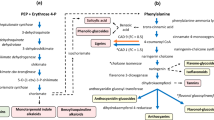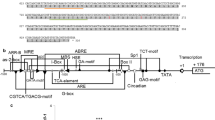Abstract
Isoprene synthase (ISPS) catalyzes the formation of isoprene, an important volatile terpenoid with strong effects on global atmospheric chemistry and protective physiological functions in plant leaves. Many terpene synthase genes including isoprene synthase, a member of the TPS-b cluster of this numerous gene family, were already functionally analysed but much less is known about regulation of their promoters. To study regulation of the PcISPS gene in detail we developed transgenic Grey poplar (Populus × canescens) and Arabidopsis thaliana plants in which the PcISPS promoter is fused to enhanced green fluorescent protein (E-GFP) and β-glucuronidase (GUS) reporter genes. We analysed these reporters during plant development, for organ specificity and in plants subjected to different light and temperature regimes. We observed low promoter activity in non-isoprene emitting tissue like roots where ISPS gene is transcribed but no active enzyme is detectable. In leaves we demonstrate that light and temperature directly modulate ISPS promoter activity. Moreover, with confocal laser scanning microscopy we show a cell specific gradient of ISPS promoter activity within the leaf parenchyma depending on light direction. Our results indicate that ISPS promoter activity, which correlates with basal isoprene emission capacity, is not uniformly distributed within leaf tissue and that it can adapt rapidly towards internal as well as external environmental stimuli.






Similar content being viewed by others
References
Affek HP, Yakir D (2002) Protection by isoprene against singlet oxygen in leaves. Plant Physiol 129:269–277
Amin J, Ananthan J, Voellmy R (1988) Key features of heat shock regulatory elements. Mol Cell Biol 8:3761–3769
Behnke K, Ehlting B, Teuber M et al (2007) Transgenic, non-isoprene emitting poplars don’t like it hot. Plant J 51:485–499
Bohlmann J, Meyer-Gauen G, Croteau R (1998) Plant terpenoid synthases: molecular biology phylogenetic analysis. Proc Natl Acad Sci USA 95:4126–4133
Bohlmann J, Stauber EJ, Krock B et al (2002) Gene expression of 5-epi-aristolochene synthase formation of capsidiol in roots of Nicotiana attenuata and N. sylvestris. Phytochemistry 60:109–116
Byun-McKay A, Godard KA, Toudefallah M et al (2006) Wound induced terpene synthase gene expression in Sitka spruce that exhibit resistance or susceptibility to attack by the white pine weevil. Plant Physiol 140:1009–1021
Chen F, Tholl D, D’Auria JC et al (2003) Biosynthesis emission of terpenoid volatiles from Arabidopsis flowers. Plant Cell 15:481–494
Chen F, Ro DK, Petri J et al (2004) Characterization of a root-specific Arabidopsis terpene synthase responsible for the formation of the volatile monoterpene 1, 8-cineole. Plant Physiol 135:1956–1966
Clough SJ, Bent AF (1998) Floral dip: a simplified method for Agrobacterium-mediated transformation of Arabidopsis thaliana. Plant J 16:735–743
Cui M, Vogelmann TC, Smith WK (1991) Chlorophyll and light gradients in sun and shade leaves of Spinacia oleracea. Plant Cell Environ 14:493–500
De Moraes CM, Mescher MC, Tumlinson JH (2001) Caterpillar induced nocturnal plant volatiles repel conspecific females. Nature 410:577–580
Dudareva N, Martin D, Kish CM et al (2003) E-β-ocimene myrcene synthase genes of floral scent biosynthesis in snapdragon: function expression of three terpene synthase genes of a new terpene synthase subfamily. Plant Cell 15:1227–1241
Fares S, Loreto F, Kleist E et al (2008) Stomatal uptake stomatal deposition of ozone in isoprene monoterpene emitting plants. Plant Biol (Stuttg) 10:44–54
Fischbach RJ (2000) Monoterpensynthasen in Blättern der Fichte Picea abies L Karst und der Steineiche Quercus ilex L: Charakterisierung, Klonierung und zeitliche Variabilität. PhD thesis, University of Freiburg, Germany. Schriftenreihe des Fraunhofer-Instituts Atmosphärische Umweltforschung ISBN: 3-8265-9121-6, 188 pp
Fuentes JD, Lerdau M, Atkinson R et al (2000) Biogenic hydrocarbons in the atmospheric boundary layer: a review. Bull Am Met Soc 81:1537–1575
Guenther AB, Zimmermann PR, Harley P et al (1993) Isoprene monoterpene emission rate variability: model evaluations sensitivity analyses. J Geophys Res 98:12609–12617
Guenther AB, Karl T, Harley P et al (2006) Estimates of global terrestrial isoprene emission using MEGAN (Model of Emissions of Gases and Aerolsols from Nature). Atmos Chem Phys 6:3181–3210
Herde M, Gärtner K, Köllner TG et al (2008) Identification and regulation of TPS04/GES, an Arabidopsis geranyl-linalool synthase catalyzing the first step in the formation of the insect-induced volatile C16-homoterpene TMTT. Plant Cell 20:1152–1168
Hutzler P, Fischbach R, Heller W et al (1998) Tissue localisation of phenolic compounds in plants by confocal laser scanning microscopy. J Exp Bot 49:953–965
Jefferson RA (1987) Assaying chimeric genes in plants: the GUS gene fusion system. Plant Mol Biol Rep 5:387–405
Jefferson RA, Kavanagh TA, Bevan MW (1987) GUS fusions: B-glucuronidase as a sensitive and versatile gene fusion marker in higher plants. EMBO J 6:3901–3907
Kaplan JO, Folberth G, Hauglustaine DA (2006) Role of methane and biogenic volatile organic compound sources in late glacial and Holocene fluctuations of atmospheric methane concentrations. Gl Biochem Cycl 20:GB2016. doi:10.1029/2005GB002590
Kappers IF, Aharoni A, van Herpen TW et al (2005) Genetic engineering of terpenoid metabolism attracts bodyguards to Arabidopsis. Science 309:2070–2072
Karimi M, Inzé D, Depicker A (2002) GATEWAYTM vectors for Agrobacterium-mediated plant transformation. Trends Plant Sci 7:193–195
Kesselmeier J, Staudt M (1999) Biogenic volatile organic compounds VOC: an overview on emission, physiology and ecology. J Atmos Chem 33:23–88
Köllner TG, Schnee C, Gershenzon J et al (2004) The sesquiterpene hydrocarbons of maize Zea mays form five groups with distinct developmental organ-specific distributions. Phytochemistry 65:1895–1902
Kroll JH, Ng NL, Flagan RC et al (2006) Secondary organic aerosol formation from isoprene photooxidation. Env Sci Technol 40:1869–1877
Kuhn U, Rottenberger S, Biesenthal T et al (2004) Strong correlation between isoprene emission and gross photosynthetic capacity during leaf phenology of the tropical tree species Hymenaea courbaril with fundamental changes in volatile organic compounds emission composition during early leaf development. Plant Cell Environ 27:1469–1485
Kuzma J, Fall R (1993) Leaf isoprene emission rate is dependent on leaf development the level of isoprene synthase. Plant Physiol 101:435–440
Lehning A, Zimmer W, Zimmer I et al (2001) Modelling of annual variations of oak Quercus robur L isoprene synthase activity to predict isoprene emission rates. J Geophys Res 106:3157–3166
Leplé JC, Brasileiro ACM, Michel MF et al (1992) Transgenic poplars: expression of chimeric genes using four different constructs. Plant Cell Rep 11:137–141
Lloyd GB, McCown BH (1980) Commercially feasible micropropagation of mountain laurel Kalmia latifolia by use of shoot-tip culture. Proc Int Plant Prop Soc 30:421–427
Loivamäki M, Louis S, Cinege G et al (2007a) Circadian rhythms of isoprene biosynthesis in Grey Poplar leaves. Plant Physiol 143:540–551
Loivamäki M, Gilmer F, Fischbach RJ et al (2007b) Arabidopsis, a model to study biological functions of isoprene emission? Plant Physiol 144:1066–1078
Loivamäki M, Mumm R, Dicke M et al (2008) Isoprene interferes with the attraction of bodyguards by herbaceous plants. Proc Natl Acad Sci USA 105:17430–17435
Loreto F, Velikova V (2001) Isoprene produced by leaves protects the photosynthetic apparatus against ozone damage, quenches ozone products, reduces lipid peroxidation of cellular membranes. Plant Physiol 127:1781–1787
Loreto F, Ciccioli P, Brancaleoni E et al (1998) A hypothesis on the evolution of isoprenoid emission by oaks based on the correlation between emission type Quercus taxonomy. Oecologia 115:302–305
Mayrhofer S, Teuber M, Zimmer I et al (2005) Diurnal and seasonal variation of isoprene biosynthesis-related genes in Grey poplar leaves. Plant Physiol 139:474–484
Mazza G, Cottrell T (1999) Volatile components of roots, stems, leaves and flowers of Echinacea species. J Agric Food Chem 47:3081–3085
Monson RK, Harley PC, Litvak ME et al (1994) Environmental developmental controls over the seasonal pattern of isoprene emission from aspen leaves. Oecologia 99:260–270
Owen S, Peñuelas J (2005) Opportunistic emissions of volatile isoprenoids. Trends Plant Sci 10:420–426
Pichersky E, Gershenzon J (2002) The formation function of plant volatiles: perfumes for pollinator attraction defence. Curr Opin Plant Biol 5:237–243
Poisson N, Kanakidou M, Crutzen PJ (2000) Impact of non-methane hydrocarbons on tropospheric chemistry the oxidizing power of global troposphere: three-dimensional modelling results. J Atmos Chem 36:157–230
Rasmann S, Turlings TC (2007) Simultaneous feeding by aboveground belowground herbivores attenuates plant-mediated attraction of their respective natural enemies. Ecol Lett 10:926–936
Rieping M, Schöffl F (1992) Synergistic effect of upstream sequences, CCAAT box elements, HSE sequences for enhanced expression of chimaeric heat shock genes in transgenic tobacco. Mol Gen Genet 231:226–232
Ro DK, Ehlting J, Keeling CI et al (2006) Microarray expression profiling functional characterization of AtTPS genes: duplicated Arabidopsis thaliana sesquiterpene synthase genes At4g13280 At4g13300 encode root-specific wound-inducible Z-γ-bisabolene synthases. Arch Biochem Biophys 448:104–116
Sasaki K, Ohare K, Yazaki K (2005) Gene expression characterization of isoprene synthase from Populus alba. FEBS Lett 579:2514–2518
Schnitzler JP, Graus M, Kreuzwieser J et al (2004) Contribution of different carbon sources to isoprene biosynthesis in poplar leaves. Plant Physiol 135:152–160
Schnitzler JP, Zimmer I, Bachl A et al (2005) Biochemical properties of isoprene synthase in poplar Populus × canescens. Planta 222:777–786
Sharkey TD, Wiberley AE, Donohue AR (2007) Isoprene emission from plants: why and how. Ann Bot 101:5–18
Steele CL, Crock J, Bohlmann J et al (1998) Sesquiterpene synthase from Grand fir Abies grandis. Comparison of constitutive wound-induced activities, cDNA isolation, characterization, bacterial expression of δ-serinene synthase γ-humulene synthase. J Biol Chem 273:2078–2089
Tan XY, Liang WQ, Liu CJ et al (2000) Expression pattern of +-δ-cadinene synthase genes biosynthesis of sesquiterpene aldehydes in plants of Gossypium arboretum L. Planta 210:644–651
Terashima I, Saeki T (1983) Light environment within a leaf. I. Optical properties of paradermal sections of Camellia leaves with special reference to differences in the optical properties of palisade and spongy tissues. Plant Cell Physiol 24:1493–1501
Tholl D, Chen F, Petri J et al (2005) Two sesquiterpene synthases are responsible for the complex mixture of sesquiterpenes emitted from Arabidopsis flowers. Plant J 42:757–771
Van Schie CCN, Haring MA, Schuurink RC (2007) Tomato linalool synthase is induced in trichomes by jasmonic acid. Plant Mol Biol 64:251–263
Vogelmann TC, Han T (2000) Measurement of gradients of absorbed light in spinach leaves from chlorophyll fluorescence profiles. Plant Cell Environ 23:1303–1311
Vogelmann TC, Martin G (1993) The functional significance of palisade tissue: penetration of directional vs diffuse light. Plant Cell Environ 16:65–72
Wiberley AE, Linskey AR, Falbel TG et al (2005) Development of the capacity for isoprene emission in kudzu. Plant Cell Environ 28:898–905
Xiao H, Lis JT (1988) Germline transformation used to define key features of heat-shock response elements. Science 239:1139–1142
Xu YH, Wang JW, Wang S et al (2004) Characterization of GaWRKY1, a cotton transcription factor that regulates the sesquiterpene synthase gene (+)-δ-cadinene synthase A. Plant Physiol 135:507–515
Yin S, Mei L, Newman J et al (1997) Regulation of sesquiterpene cyclase gene expression. Characterization of an elicitor-pathogen-inducible promoter. Plant Physiol 115:437–451
Zabaleta E, Assad N, Oropeza A et al (1994) Expression of one of the members of the Arabidopsis chaperonin 60β gene family is developmentally regulated and wound-repressible. Plant Mol Biol 24:195–202
Acknowledgements
We greatly acknowledge the technical support of I. Zimmer, M. Bauerfeind (IMK-IFU, Garmisch-Partenkirchen) and M. Kay (University of Braunschweig) for biochemical analysis and cultivation of poplars. The study was financially supported by the European Commission in the frame of the Marie-Curie Research Training Network ISONET (J.P.S) and by the German Science Foundation (J.P.S SCHN653/4, R.H.HA3107/3) within the German joint research group ‘Poplar—A model to address tree-specific questions’.
Author information
Authors and Affiliations
Corresponding author
Additional information
Gyöngyi Cinege and Sandrine Louis contributed equally to the work.
Rights and permissions
About this article
Cite this article
Cinege, G., Louis, S., Hänsch, R. et al. Regulation of isoprene synthase promoter by environmental and internal factors. Plant Mol Biol 69, 593–604 (2009). https://doi.org/10.1007/s11103-008-9441-2
Received:
Accepted:
Published:
Issue Date:
DOI: https://doi.org/10.1007/s11103-008-9441-2




